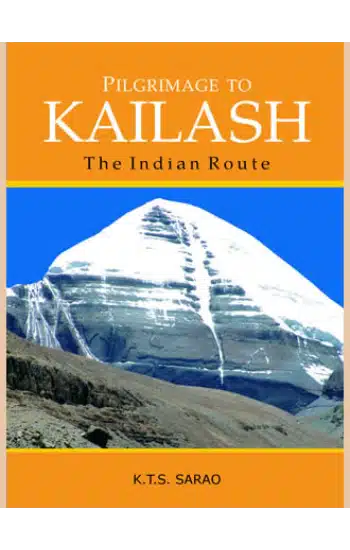
Save: 15%

Save: 15%
PILGRIMAGE TO KAILASH: The Indian Route
Publisher:
| Author:
| Language:
| Format:
Publisher:
Author:
Language:
Format:
₹1,450 ₹1,233
Save: 15%
In stock
Ships within:
In stock
| Book Type |
|---|
ISBN:
Page Extent:
Since times immemorial, Indian renunciates have been going on pilgrimage to Mount Kailash and Lake Manasarovar. But after the take over of Tibet by China, this pilgrimage stopped in 1959. However, as a result of the Sino-Indian treaty signed in 1981 and a limited form of religious liberalization in Tibet, the Chinese government agreed to let in a small number of Indian passport holders every year to enter Tibet directly from India via the Lipu Lekh crossing and go to Mount Kailash and Lake Manasarovar for the purposes of worship and circumambulation. Large chunk of the Indian territory through which the Indian pilgrims trek is out of bounds to foreigners. This trek is considered one of the most difficult pilgrimage treks in the world. The author undertook this pilgrimage twice. The first one took place in 2002, the year of the Water Horse, which in the Sino-Tibetan duodenary cycle is considered a particularly auspicious time to make a pilgrimage to a holy place. Merit thus accumulated by undertaking pilgrimage during the year of the Water Horse is considered to be multiplied manifold. The second visit was made during the summer of 2004. Another trip was undertaken in 2006 up to Adi Kailash. In the pre-1959 period, the pilgrimage to Kailash and Manasarovar used to mainly attract sadhus from India. The general public mostly avoided this pilgrimage due to the harsh climate, tough terrain, and lawlessness in the region. However, pilgrimage in present times is largely undertaken by lay people. Not only the governments of India and China but also various local organizations on both sides of the border take interest in this exercise. As a result of this, many changes of far reaching consequences are taking place in the Himalayas. The author has made an attempt in this book to examine the history of the Indian tradition of pilgrimage to Kailash and Manasarovar; the perils and difficulties involved in this pilgrimage; the social, religious, geo-political, and economic factors on both sides of the Sino-Indian border that have affected, and have been affected in turn by this pilgrimage.
Since times immemorial, Indian renunciates have been going on pilgrimage to Mount Kailash and Lake Manasarovar. But after the take over of Tibet by China, this pilgrimage stopped in 1959. However, as a result of the Sino-Indian treaty signed in 1981 and a limited form of religious liberalization in Tibet, the Chinese government agreed to let in a small number of Indian passport holders every year to enter Tibet directly from India via the Lipu Lekh crossing and go to Mount Kailash and Lake Manasarovar for the purposes of worship and circumambulation. Large chunk of the Indian territory through which the Indian pilgrims trek is out of bounds to foreigners. This trek is considered one of the most difficult pilgrimage treks in the world. The author undertook this pilgrimage twice. The first one took place in 2002, the year of the Water Horse, which in the Sino-Tibetan duodenary cycle is considered a particularly auspicious time to make a pilgrimage to a holy place. Merit thus accumulated by undertaking pilgrimage during the year of the Water Horse is considered to be multiplied manifold. The second visit was made during the summer of 2004. Another trip was undertaken in 2006 up to Adi Kailash. In the pre-1959 period, the pilgrimage to Kailash and Manasarovar used to mainly attract sadhus from India. The general public mostly avoided this pilgrimage due to the harsh climate, tough terrain, and lawlessness in the region. However, pilgrimage in present times is largely undertaken by lay people. Not only the governments of India and China but also various local organizations on both sides of the border take interest in this exercise. As a result of this, many changes of far reaching consequences are taking place in the Himalayas. The author has made an attempt in this book to examine the history of the Indian tradition of pilgrimage to Kailash and Manasarovar; the perils and difficulties involved in this pilgrimage; the social, religious, geo-political, and economic factors on both sides of the Sino-Indian border that have affected, and have been affected in turn by this pilgrimage.
About Author
Reviews
There are no reviews yet.
Related products
COMMUNICATION WITH GOD: The Daily Puja Ceremony in the Jagannath Temple
Save: 15%
Revealing Deeper Meanings: Narratives From Veda To Puranas
Save: 15%
The Architecture Of The Hindus: Edited And Revised Edition
Save: 15%
Cosmology And Cosmic Manifestations: Shaiva Thought And Art Of Kashmir
Save: 15%
Book Of Indian Eras: With Tables For Calculating Indian Dates
Save: 15%
RELATED PRODUCTS
Book Of Indian Eras: With Tables For Calculating Indian Dates
Save: 15%
COMMUNICATION WITH GOD: The Daily Puja Ceremony in the Jagannath Temple
Save: 15%
Cosmology And Cosmic Manifestations: Shaiva Thought And Art Of Kashmir
Save: 15%
Discourses On Shri Ramcharitmanas (Set Of 2)
Save: 0%
EXPERIENCING THE GODDESS: On the Trail of the Yoginis
Save: 15%
Megalithic Traditions In India: Archaeology And Ethnography (Set Of 2 Vols.)
Save: 15%



Reviews
There are no reviews yet.